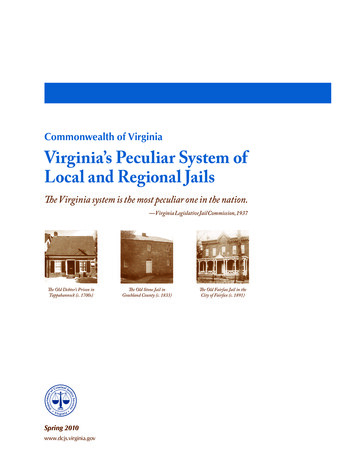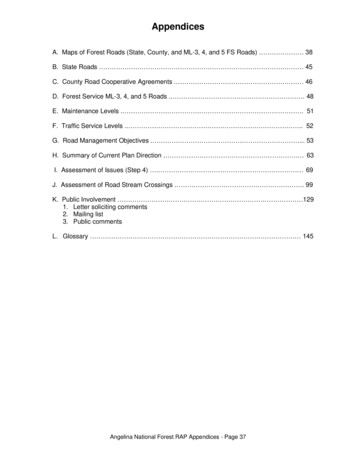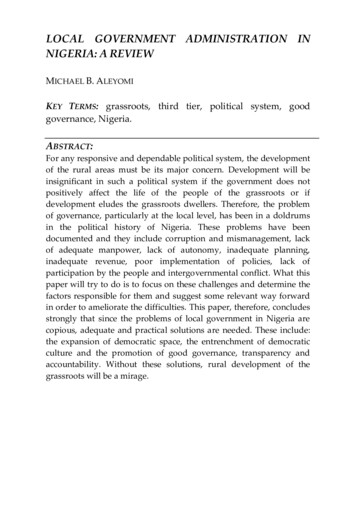
Transcription
Commonwealth of VirginiaVirginia’s Peculiar System ofLocal and Regional JailsThe Virginia system is the most peculiar one in the nation.— Virginia Legislative Jail Commission, 1937The Old Debtor’s Prison inTappahannock (c. 1700s)Spring 2010www.dcjs.virginia.govThe Old Stone Jail inGoochland County (c. 1833)The Old Fairfax Jail in theCity of Fairfax (c. 1891)
Table of Contents1 Introduction.12 Purpose and Function of Virginia’s Jails. 1Types of Inmates.1Entering Jail.23 Local and Regional Jails. 34 Statewide Jail System. 45 Funding the Jails – Construction and Operation. 5Construction Funding.5Operational Funding.6Comparison to Other States.6Federal Funding.66 Programs and Services in the Jails. 77 Issues Impacting Jails. 7Overcrowding.7Security Classification.8Work Release.8Good Time.9Mental Health.9Alternatives to Incarceration.9Inmate Population Forecast.10Reentry.118 Virginia’s Jail System. 119 Acknowledgements.1210 Appendices.13Appendix A – Capacity, Operating Cost, Average Daily Population, andCommitment Data for Local and Regional Jails.13Appendix B – Jail Cost Breakdowns for Local Jails, Regional Jails, andLocal Jail Farms.1511 Endnotes.18.This document is available on the internet at www.dcjs.virginia.gov
Virginia’s Peculiar System of Local and Regional Jails1 IntroductonThe Virginia system is the most peculiar one in the nation. The grounds and buildings are owned by the countiesand cities, the jails are operated by the sheriffs and city sergeants, authority is divided between these officialsand the county supervisors or town councils and the circuit or corporation courts, and the state pays the cost ofkeeping the prisoners. The State, although paying the bills, has no actual authority over the jails other than the power of inspectionand recommendation by the Department of Public Welfare, truly an anomalous situation.- Virginia Legislative Jail Commission, 19371Although much has changed since the Virginia LegislativeJail Commission made its report, the “peculiarity” that thereport highlighted still remains largely true. Responsibilitiesfor jails – construction, operation, certification, funding, etc.– are spread across multiple state and local agencies. Thestate provides substantial funding for jails, but other thancertifying and inspecting the facilities, it has little directauthority over operations.Because Virginia’s jail system is so fragmented – and oftendifficult to understand when trying to develop policies andprograms concerning jails – this report was developed toprovide a better understanding of the purpose, operations,funding, and development of Virginia’s jail system.2 Purpose and Function of Virginia’s JailsVirginia jails are essential to the State’s criminal justice system.- Joint Legislative Audit and Review Commission, 19962Jails have been used in Virginia throughout its history, firstmentioned in Jamestown documents in 1608.3 They serve acrucial function within the state’s criminal justice system.They provide secure confinement, at the local level, for localand state-responsible inmates, as well as federal prisoners.Types of InmatesIndividuals confined in Virginia’s local and regional jails fallinto one of three broad categories: Local-responsible inmates, including:–– Individuals charged with a felony, misdemeanor, orordinance violation, who are not released on bail (COV§ 19.2, Chapter 9).4–– Offenders sentenced to jail following conviction for amisdemeanor.–– Offenders sentenced to twelve months or less, followingconviction for a felony.–– Offenders committed for violation of conditions ofprobation, parole, or post-release supervision, to awaita probation/parole revocation hearing.–– Offenders sentenced to jail for violation of a localordinance. State-responsible inmates, which are offenders who havebeen sentenced to incarceration for one year or more. TheDepartment of Corrections (DOC) is to take these inmatesinto custody within sixty days of the final sentencingorder being mailed to DOC by the clerk of the court.5A jail may also have a contract with DOC to hold stateresponsible inmates on contract, and as part of a workrelease program.6 Many jails also incarcerate federal prisoners, forwhich they receive per diem payments from the federalgovernment.7 The General Assembly has directed jailsto give priority to housing local-responsible inmates andstate-responsible inmates over federal prisoners.8Local-responsible inmates make up the largest portion ofthe jail population, about 72% in fiscal years 2007-2009.Generally, the local-responsible population is the onepeople think of as the “jail” population, but it is important toremember that 28% of the bed space in jails is used by stateand federal inmates.1
Virginia’s Peculiar System of Local and Regional JailsAverage Daily Population in the Jails25,00020,00015,00010,0005,0000FY 2007Local-Responsible InmatesFY 2008State-Responsible InmatesFY 2009Federal PrisonersEntering JailWhen an individual is arrested, a law enforcement officerpresents the arrested person to a magistrate or other courtofficial, who will determine whether that person shouldawait trial in jail or be released on bail. If the judicial officerdetermines that the individual is appropriate for release onrecognizance, the court will set terms and conditions forrelease. These terms set by the judicial officer may include asecured or unsecured bond, as well as restrictions on traveland compliance with curfew or conditions.9 If the magistrateor judge determines that the accused is charged with anoffense that requires bail to be denied or if it is determinedthat there is probable cause that the accused will not appearat required court hearings or that the individual’s libertywill constitute an unreasonable danger to the individual orthe public, bail will be denied, and the individual will becommitted to jail to await trial.10 Alternately, if the courtrequires a secured bond for release on bail, the accused willremain in jail if the terms of the bond cannot be met.11jury then determines if there is probable cause to believethat the accused person has committed the crime in question.If there is probable cause, the case goes to the CircuitCourt, where it may be tried before a jury or a judge. Ifthe Circuit Court finds the defendant guilty, the court willimpose a sentence which may include confinement in jailor prison.14 Felons sentenced to twelve months or less areconsidered local-responsible inmates, and will remain injail. Felons sentenced to one year or more are consideredstate-responsible inmates. Upon final sentencing (whichmay involve multiple trials in multiple jurisdictions, if theinmate has pending charges in other localities), the clerkof the court informs the Department of Corrections that theinmate has been committed to the state. DOC must take theinmate into custody within sixty days of that notice, or elsethe state will be required to pay a supplemental per diem tothe jail (see Funding the Jails on page 5).For individuals charged with a misdemeanor or violationof a local ordinance, guilt or innocence is determined bythe General District Court judge. If the judge finds thedefendant guilty (there are no jury trials in General DistrictCourt), the judge then determines the penalty and imposessentence, which may include a term in jail.12 The offendermay be sentenced to serve those days consecutively, or thecourt may “impose the time to be served on weekends ornonconsecutive days” so that the offender can maintaingainful employment.13 Typically, “weekender” sentencesallow inmates to serve their sentence while keeping theirjobs. Inmates given such a sentence are required to pay anamount to offset the cost of his or her incarceration.For individuals charged with a felony, the General DistrictCourt conducts a hearing to determine if there is sufficientevidence in the case to send it to the grand jury. The grandHanover Jail2
Virginia’s Peculiar System of Local and Regional Jails3 Local and Regional JailsThere are two main types of jail facilities currently inoperation in Virginia. Local governments, with state support, pay for jailconstruction costs. When they believe it necessary, theyalso provide salary supplements, in addition to that paidby the Compensation Board. Local jails generally serve the single locality in whichthey are located (though they may hold inmates for otherlocalities). These facilities are managed Magistrates decide whether to release anby locally elected sheriffs. Local jailsaccused to bail or to commit them to jail to[T]he use of regionalaccounted for 54.2% of total jail inmateawait trial.21jailshasproliferateddays in fiscal year 2008.15 Local judges also make initial bailin an attempt to Regional jails provide jail space to multipledecisions, sentence inmates, and can modifyreduce operating costslocalities, which may or may not operatethe sentence of an inmate in jail. Judgestheir own local jails. These facilities arealso have the authority to fine a sheriff orby replacing older,administered by a superintendent, who servessuperintendent that has “in any respectsmaller, inefficientthe regional jail board or jail authority. Thefailed to perform his duties with respect tosuperintendents have the same authority asthe operation of the jail.”22local facilities.sheriffs, with respect to offenders committedSome localities use only a local or regional jail,to their jails. The jail boards consist of, atwhile a few larger localities take advantage of both. Over theminimum, the sheriffs of the participating localities andpast several decades, the use of regional jails has proliferatedone appointed representative of each participating localin an attempt to reduce operating costs by replacing older,government. Alternate members may be appointed.16smaller, inefficient local facilities. Between 1988 and 2009,Regional jails accounted for 44.8% of total jail inmate daysthe number of local jails dropped from 90 to 45, while thein fiscal year 2008.17number of regional jails increased from six to 20.23A third facility type accounted for the remaining 1.0% ofAccording to the Compensation Board’s FY 2008 Jail Costjail inmate days in fiscal year 2008. Localities can establishReport, the average operating cost of holding one inmate forjail farms, “where any person convicted and sentenced toone day in a local jail was 73.71, while the average operatingconfinement” in jail “may be confined and required to docost per inmate day in a regional jail was 56.35. Thosesuch work as may be assigned him during the term of hisoperating costs vary across individual local and regionalsentence. A local jail farm may be used to hold or confinejails, from a high of 169.45 per inmate day (Loudounany person who could be lawfully held or confined in a jailCounty Jail) to a low of 36.77 per inmate day (Piedmontoperated by the county or city.”18 There are currently twoRegional Jail).24 (See Appendix B for cost breakdowns forlocally-operated jail farms, in cities that are also served bylocal jails, regional jails, and local jail farms, produced bya local jail. They are administered by superintendents whothe Compensation Board.)report to the local governing body. 19Jail Operating CostsAt the local and regional level, the major entities involvedin the jails include: Local sheriffs and regional jail superintendents, who arethe jail administrators, have the principal responsibility forthe custodial care of inmates. They maintain the securityof their facilities, and are responsible for the health andsafety of their prisoners. They are also responsible forkeeping and reporting records on their population to theCompensation Board and the Department of Corrections,and they ensure that their jails comply with standards setby the state Board of Corrections.20 Local deputy sheriffs and regional jail officers (“guards”),who assist the sheriff/superintendent in their duties, and arefunded by the state through the Compensation Board. 80 60 40 20 0FY 2006Local JailsFY 2007FY 2008Regional JailsTogether, but independently, these local and regional jailscomprise Virginia’s statewide system of jails.3
Virginia’s Peculiar System of Local and Regional Jails4 Statewide Jail SystemIt is perhaps overly broad to refer to Virginia’s jails as beinga “system.” That designation implies a certain amountof central planning and authority, rather than the loosecollection of independent local and regional correctionalfacilities that are Virginia’s jails.and certification audits. Jails must be meet BOC standardsto be certified by DOC. Funding for jail constructionis provided in the DOC’s budget as stated in theAppropriations Act, for construction projects approved byBOC.29 State-responsible inmates are transferred to DOC“within sixty days of the date on which thefinal sentencing order is mailed by certifiedIt is perhaps overlyletter or sent by electronic transmission to theDirector by the clerk” of the court.30broad to refer toOriginally, the jails in Virginia were under theauthority of the Governor. In 1779, control wasvested in the circuit courts.25 There is no stateDepartment of Jails. Unlike the state prisonsystem, which is operated by a state Department The Compensation Board (CB) providesVirginia’s jails asof Corrections, no state agency has directthe state portion of operating costs for jails,being a “system.”operating authority over the “system” of jails,including salaries and benefits of correctionalthough jails must be certified by state auditorsofficers and support staff, costs for certain(see below). Each individual jail facility isprograms and services, and office expenses.managed by a locally-elected sheriff, or by appointedAdditionally, the Compensation Board dispenses inmateregional authorities.26 However, the independent jails areper diem payments.31 As part of fulfilling this role, theconnected via the state’s system of oversight and funding,CB maintains the LIDS database, which tracks personsand the Local Inmate Data System (LIDS) maintained byentering and exiting jails, for the purpose of determiningthe Compensation Board (CB).appropriate per diem levels. The CB publishes an annualreport on jail operating costs.Inmates are frequently transferred between jails, by agreementbetween the facilities. Inmates may have outstanding The Department of Criminal Justice Services (DCJS)charges in multiple jurisdictions; after being committedestablishes “compulsory minimum entry-level, inand confined while awaiting trial in one jurisdiction, theyservice, and advanced training standards for personsmay be transferred to another jail to await trialemployed as deputy sheriffs and jail officersor a probation or parole revocation hearing inby local criminal justice agencies.”32 DCJSthat jurisdiction’s court. An individual inmatealso, in consultation with BOC, reviews[N]o state agencymay be transferred between jails multiple timesthe Community Based Corrections Planhas direct operatingbefore finally being released.27submitted by localities seeking constructionauthority over theof a new jail.33 DCJS also reviews, withAlthough no one state agency has ultimatethe DOC, Home Electronic Incarceration“system” of jails administrative authority, several state agenciesstandard operating procedures for jailshave some kind of funding or oversight[However], severalseeking reimbursement for alternativeresponsibilities for the state’s jail system:state agenciespayment days from the CB. The Board of Corrections (BOC) setshave some kind of The Treasury Board and the Virginia“standards for the construction, equipment,Public Building Authorities may also befunding or oversightadministration and operation” of jails.28 BOCinvolved in capital costs for jail construction,also approves new jail construction projects.responsibilities depending on the manner of payment selectedThe BOC can decertify a jail if the sheriff orby the General Assembly.34jail administrator does not comply with life,health, and safety requirements within the time allotted, The Department of Health inspects jails to ensurethe Board can begin the process of closing the facility inthat the kitchen facilities comply with the state’s Foodconjunction with an appropriate circuit court.Regulations, and that all areas of the facility comply withBOC standards of facility cleanliness.35 The Department of Corrections (DOC) monitorsthe jails’ compliance with BOC standards throughmonitoring visits, annual inspections, and accreditation4
Virginia’s Peculiar System of Local and Regional Jails5 Funding the Jails –Construction and OperationThe most obvious role of the state in Virginia’s jail systemis funding. Most states put little or no state funds into localjails, but Virginia has a long history of state involvementin jail financing. Virginia’s state support for jails dates tocolonial times; the first per diem payment, five pounds oftobacco, was approved in 1613.36 Much has changed inthe intervening centuries, but Virginia’s role in fundingconstruction and operations remains significant.Lumpkin JailConstruction FundingThe state’s role in construction funding has evolved overtime. State support for jail construction began in 1968. Thestate provided localities for a combination of localities upto half the cost of construction or enlargement of a jail, notto exceed 25,000 (per participating locality) for any oneproject. In 1981, the General Assembly amended the processto include reimbursement for renovations (in addition toconstruction and enlargement), and to change the maximumreimbursement cap to be based on the size of the jail facility,with larger jails receiving a larger reimbursement. Thereimbursement caps were doubled in 1987.37In 1996, the Virginia General Assembly declared amoratorium on all jail construction projects. Prior to this,the Board of Corrections approved jail construction projectswithout legislative involvement. With the moratorium, newprojects require a legislative exemption, as part of a budgetamendment, before they can be reviewed by the BOC.41Once the project has received an exemption, planningdocuments are submitted to DOC. These documents includea Community Based Corrections Plan (CBCP), whichwill be reviewed by DOC and DCJS. The CBCP mustinclude a jail inmate population forecastIn 1989, the General Assembly made furtherspecific to the locality or region seeking the[T]he first per diemmodifications, designed to encourage multinew jail, and it must describe any existingjurisdictional cooperation through regionalpayment, five poundsfacilities and programs that should servejails. The state would pay a maximum of fiftyas alternatives to incarceration.42 DOC willof tobacco,percent of the construction, enlargement, and/also review a planning study that must bewas approvedor renovation costs of regional jails, whileincluded in the submission, which must havereimbursements for local jails were still capped.details on the planned jail, staffing needs,in 1613.The General Assembly also greatly expandeddetailed construction cost estimates, a sixthe responsibilities of the Board and Departmentyear operating budget, and other factors.43of Corrections with regard to jail construction.38If a proposed jail is exempted from the moratorium andapproved by the Board of Corrections, it can be submittedDespite these changes, construction costs continued to be ato the Governor for final approval prior to including stateconcern. The General Assembly enacted reforms in 1993,funding for the project in the proposed biennial budget.changing reimbursement for construction, expansion, andrenovation projects. The reforms sought to further encouragethe use of regional jails by limiting reimbursement of localjail construction to 25%, but continuing to reimburse upto 50% of regional jail construction costs.39 Three or morejurisdictions must participate in the regional jail to receivethis higher reimbursement. The localities are responsible forthe remainder of construction costs.Between 1993 and 2008, the state’s share of local andregional jail construction costs was almost 536 million,over 44% of total construction costs.40Operational FundingThe state also pays a large proportion of the operatingcosts of both local and regional jails. The CB pays 100%of base salaries and benefits for local jail deputies andregional jail officers, up to the number of officers requiredby staffing ratios established by the General Assembly in theAppropriations Act. The reimbursable base salaries of thelocal and regional jail correctional officers are commensuratewith DOC correctional officer salaries. Individual jails or5
Virginia’s Peculiar System of Local and Regional Jailsregions may choose to provide salary supplements, but theparticipating localities are responsible for the additionalcost.44 The jails can employ additional correctional staff, butthe localities are responsible for the salaries and benefits ofthose additional staff. The Compensation Board also paystwo-thirds of salaries of medical and treatment staff in localand regional jails.45The General Assembly adopted staffingstandards, based on inmate populations, in1988.46 The 2009 Appropriations Act specifiesthat the Compensation Board shall fund onejail deputy (or regional jail correctional officer)for every three beds of operational capacity(determined by DOC). If a jail’s averagedaily population exceeds operational capacity,the Compensation Board can fund up to oneadditional deputy/officer per five inmatesabove capacity.47Comparison to Other StatesVirginia is one of only seven states that provide state fundingfor the construction or renovation of local and regionaljails.51 Only 28 states provide any state assistance for jailoperations, and only seven of those provide more than 10per capita. Virginia spent 42 of state fundsper capita on jail operations in FY 2008, theThe Compensationsecond highest among the states.52Board pays 100%of base salaries andFederal Fundingbenefits for local jailLocal and regional jails may also receiveprisoners committed under the authority of thedeputies and regionalUnited States. On any given month, about 25 tojail officers 30 jails hold federal prisoners. In such cases,the sheriff or superintendent collects a perdiem from the federal government.53 That perdiem can vary. The federal government has also contributedcapital construction funds for bed space within four local orThe Compensation Board also sets staffing standardsregional jails. These beds may be used for other prisonersfor partially funded medical, treatment, classification,when they are otherwise vacant, but federal prisoners haveand records positions, as well as cook positions, andpriority for their use.54 The General Assembly has directedadministrative staff.48the Compensation Board to recover from individual jails the One medical, classification, treatment, or records positionsstate-fund costs associated with holding federal prisoners.for every 25 inmates of average daily population;Those jails in which the federal government’s contribution Between one and five cook positions may be allocated,toward capital costs exceeded the state’s contribution aredepending upon the operating capacity of the facility;exempted.55 In FY 2008, 9.6 million was recovered from One administrative position for every 100 inmates oflocal and regional facilities holding federal inmates.56average daily population; One Local Inmate Data System technician per jail.In addition to paying salaries for recognized positions, thestate also pays a per diem to the jails for state and localresponsible inmates. In FY 2009, the per diem paymentfor local-responsible inmates was 8 per day. For stateresponsible inmates, the per diem was 8 per day duringthe first 90 days after final sentencing, at which point theinmate is designated “out of compliance,” since he or sheshould have been transferred to the state Department ofCorrections. On the 91st day, the reimbursement rate rises to 14 per day. For state-responsible inmates who are in jail oncontract as part of a work release program, the per diem is 28 per day, paid by DOC.49The per diems are paid to localities and regional jailboards in four quarterly payments, based on the actualinmate populations in the jails for the previous quarter. TheCompensation Board makes the payments using its LocalInmate Data System to identify the appropriate per diemlevels.50The former Fauquier County jail.6
Virginia’s Peculiar System of Local and Regional Jails6 Programs and Services in the JailsThe minimum standards set by the Board of Correctionsindicate some programs and services that must be presentin jails. Each jail must have a written policy describingthese programs and services, though there can be significantvariation in the type and level across jails.57 Reading materials shall be permitted in jails, unless thematerial poses a threat to security or is not in compliancewith other restrictions or guidelines. Jails must providereading materials, including periodicals no more than oneyear old.Minimum standards Upon admission into the facility, all inmates Commissary services (“canteen”) must bemust receive a medical screening. Thatavailable,allowing inmates to make purchasesset by the Board ofscreening must include identification offrom an approved list of items at a minimumCorrections indicatecurrent illnesses, health problems andof once per week.conditions; past history of communicablesome programs and Inmates must be allowed to participatediseases; identification of current symptomsvoluntarily in religious services or counselingservices that must berelated to mental health, dental problems,of their choice.present in jails.allergies, current medications, special dietary Educational services must be maderequirements, and symptoms of venerealavailable to inmates.58disease; inquiry into past and present drugand alcohol abuse, mental health status, depression, Jails may also provide a number of other programs andsuicidal tendencies, and skin conditions; and, for femaleservices, though their availability varies across individualinmates, inquiry into possible pregnancy or gynecologicalfacilities. They can include substance abuse services,problems.social services, mental health services, and re-entry Inmates must be informed, upon admission to the facility,of the procedures for obtaining medical services. Thejail’s medical and health services must be supervised bya licensed physician. Health care personnel must meetappropriate licensing or certification requirements. All inmates must have access to regular physical exerciseand some kind of recreational activities.programs. Re-entry programs might include work release,educational release, home electronic monitoring, publicwork force, and weekend sentencing/community serviceprograms. More information on some of these programsand services can be found in Issues Impacting Jailsbelow.7 Issues Impacting JailsStatewide, more than twenty thousand individuals are admitted to jail every month, and about the same number are released.These inmates – including pretrial and sentenced local-responsible prisoners, state-re
the number of local jails dropped from 90 to 45, while the number of regional jails increased from six to 20.23 According to the Compensation Board's FY 2008 Jail Cost Report, the average operating cost of holding one inmate for one day in a local jail was 73.71, while the average operating cost per inmate day in a regional jail was 56.35 .









